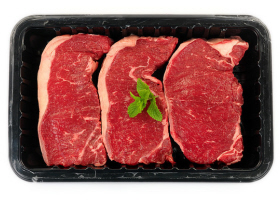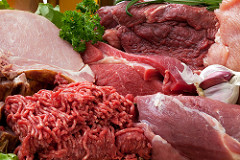



What Does the Colour of Meat Tell You?
ANALYSIS – You just pulled a package of hamburger out of the refrigerator that you bought four days ago, and the colour looks darker that when you first bought it. Has it gone bad or is that normal?Colour is important when meat is purchased, stored, and cooked. Often an attractive, bright colour is a consideration for the purchase. When safely stored in a retail or home refrigerator or freezer, it’s normal for the colour of meat and poultry to change, according to the USDA Food Safety Inspection Service (FSIS).
 Meat colour is influenced by myoglobin, a protein that is responsible for the majority of meat’s red colour. Myoglobin doesn't circulate in the blood but is fixed in the tissue cells and is purplish in colour.
Meat colour is influenced by myoglobin, a protein that is responsible for the majority of meat’s red colour. Myoglobin doesn't circulate in the blood but is fixed in the tissue cells and is purplish in colour.
When it is mixed with oxygen, it becomes oxymyoglobin and produces a bright red colour. The remaining colour comes from the haemoglobin which occurs mainly in the circulating blood, but a small amount can be found in the tissues after slaughter.
Colour is also influenced by the age of the animal, the species, sex, diet, and even the exercise it gets. As animals age, the myoglobin level increases, so the meat from older animals will appear be darker in colour. It’s normal to see variations in colour throughout a cut of meat because exercised muscles are always darker in colour.
Does a change in colour indicate spoilage?
With spoilage there can be a change in colour - often a fading or darkening. In addition to the colour change, the meat will have an off odour, be sticky or tacky to the touch, or it may be slimy. If meat has developed these characteristics, it should not be used. However, a change in colour while in the refrigerator or freezer alone does not mean the product is spoiled.
Why is some meat bright red and other meat very dark in colour when displayed at the grocery store?
 Optimum surface colour of fresh meat is usually short-lived. Expect to see:
Optimum surface colour of fresh meat is usually short-lived. Expect to see:
- Beef - cherry-red for beef
- Lamb - dark cherry-red
- Pork - grayish-pink
- Veal - pale pink
The use of a plastic wrap that allows oxygen to pass through it helps ensure that the cut meats will retain this bright red colour. However, exposure to store lighting as well as the continued contact of myoglobin and oxymyoglobin with oxygen leads to the formation of metmyoglobin, a pigment that turns meat brownish-red.
With ground beef, it can have a bright red colour on the surface, but the interior of the meat may be grayish-brown due to the lack of oxygen penetrating below the surface. This is not a sign of spoiled beef, rather it’s reflecting oxygen exposure.
To learn more about food safety and the colour of meat and poultry, click here.



